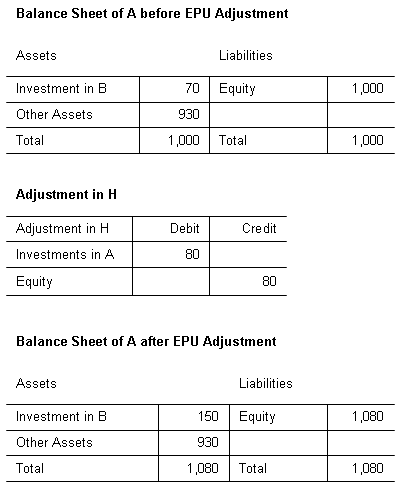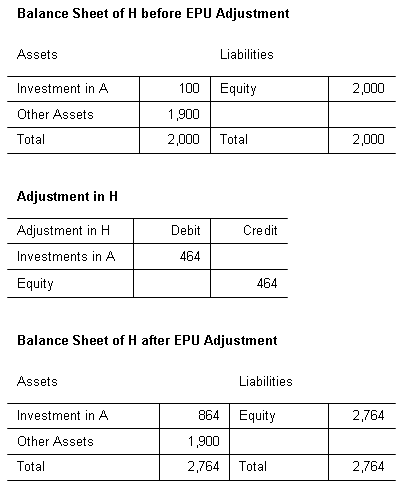Example 3: Cascading Ownership and Subholdings
EPU adjustments change the equity value in the holding company. Therefore, if one subsidiary is owned by another subsidiary, the owned subsidiary must be adjusted before the owner subsidiary is adjusted.
In the case of cascading ownership, EPU adjustments must be performed in the correct sequence, so that each owned subsidiary is adjusted before its owner. For example, if B is owned by A, which is owned by H, the EPU calculation path is B to A, and then A to H.

-
H owns 80% of A.
-
Investment of H in A at historical cost: 400
-
Actual equity of A before any adjustment: 1000
-
A owns 30% of B
-
Investment of A in B at historical cost: 70
-
Actual equity of B: 500
Adjustment in A
The EPU calculation path starts with EPU adjustment in A:
-
A owns 30% of B
-
Investment of A in B at historical cost: 70
-
Actual Equity of B: 500
-
Direct ownership percentage * Equity of entity owned - Investment = EPU Adjustment amount
-
Adjustment amount in A related to investment in B =
30% * 500 = 150 — 70 = 80
Investments in A: 80 (Debit)
Equity: 80 (Credit)

After the EPU adjustment is posted in A, and the value of A's equity is adjusted to reflect the current value of its investment in B, the EPU adjustment related to the investment of H in A can be calculated.
In this case, the formula to calculate the EPU adjustment is as follows:
Adjustment amount = (Percentage of ownership * Equity of entity owned after EPU adjustment) — Investment at historical cost-
H owns 80% of A
-
Investment of A at historical cost: 400
-
Actual Equity of A after adjustment for B: 1,180
-
Adjustment amount in H related to investment in A:
80% * 1,080 = 864 – 400 = 464
Investments in A: 464 (Debit)
Equity: 464 (Credit)
